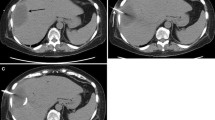Abstract
Purpose
To compare immediate percutaneous drainage of renal abscess via ultrasonographic guidance to surgical drainage.
Procedures
This was a retrospective cross-sectional study of 27 patients (mean age of 59.37 ± 12.25 years) with renal abscesses. Immediate percutaneous catheter drainage was performed in patients with pus-containing cavities greater than 3 cm who consented in the emergency section (n = 12). Other patients underwent surgical drainage (n = 11). Both groups were also treated with empirical antibiotic therapy. Four patients were treated exclusively with antibiotics and were excluded from the analysis.
Findings
Abscess size on computer tomography (CT) was similar between the percutaneous catheter drainage (PCD) patients and open surgical drainage patients (7.47 ± 1.75 cm vs. 8.67 ± 1.87 cm; P = 0.13). There was no significant difference in mean duration of hospitalization (PCD, 19.5 ± 10.5 days; surgical drainage, 14.55 ± 4.52 days. P = 0.15). Larger abscess size and higher C-reactive protein levels were important prognostic factors in both groups. Microbiological analysis revealed Escherichia coli and Klebsiella pneumoniae in most abscesses.
Conclusions
Patients treated with percutaneous drainage for renal abscess had outcomes comparable to those treated with surgical drainage.
Similar content being viewed by others
References
Salvatierra O, Bucklew WB, Morrow JW (1967) Perinephric abscess: a report of 71 cases. J Urol 98:296–302
Adachi RT, Carter R (1969) Perinephric abscess: current concepts in diagnosis and management. Am Surg 35:72–75
Meng MV, Mario LA, McCanich JM (2002) Current treatment and outcomes of perinephric abscesses. J␣Urol 168:1337–1340
Siegel JF, Smith A, Moldwin R (1996) Minimally invasive treatment of renal abscess. J Urol 155:52–55
Dalla Palma L, Pozzi-Mucelli F, Ene V (1999) Medical treatment of renal and perirenal abscesses: CT evaluation. Clin Radiol 54:792–797
Deyoe LA, Cronan JJ, Lambiase RE et al (1990) Percutaneous drainage of renal and perirenal abscesses: results in 30 patients. Am J Roentgenol 155:81–83
Yen DH, Hu SC, Tsai J, Kao WF et al (1999) Renal abscess: early diagnosis and treatment. Am J Emerg Med 17:192–197
Members of the American College of Chest Physicians/Society of Crit Care Med Consensus Conference Committee: American College of Chest Physicians/Society of Crit Care med consensus conference (1992) Definitions for sepsis and organ failure and guidelines for the use of innovative therapies in sepsis. Crit Care Med 20:864–874
Brolin RE, Flancbaum L, Ercoli FR et al (1991) Limitations of percutaneous catheter drainage of abdominal abscesses. Surg Gynecol Obstet 173:203–210
Kerlad RK Jr, Pogany AC, Jeffrey RB et al (1985) Radiologic management of abdominal abscesses. Am J␣Roentgenol 144:145–149
Hutchison FN, Kaysen GA (1988) Perinephric abscess: the missed diagnosis. Med Clin North Am 72:993–1014
Park JK, Kraus FC, Haaga JR (1993) Fluid flow during percutaneous drainage procedures: an in vitro study of the effects of fluid viscosity, catheter size, and adjunctive urokinase. Am J Roentgenol 160:165–169
Gobien RP, Stanley JH, Schabel SI et al (1985) The effect of drainage tube size on adequacy of percutaneous abscess drainage. Cardiovasc Intervent Radiol 8:100–102
Abdul-Halim H, Kehinde EO, Abdeen S et al (2005) Severe emphysematous pyelonephritis in diabetic patients: diagnosis and aspects of surgical management. Urol Int 75:123–128
Author information
Authors and Affiliations
Corresponding author
Rights and permissions
About this article
Cite this article
Hung, CH., Liou, JD., Yan, MY. et al. Immediate percutaneous drainage compared with surgical drainage of renal abscess. Int Urol Nephrol 39, 51–55 (2007). https://doi.org/10.1007/s11255-006-9033-5
Received:
Accepted:
Published:
Issue Date:
DOI: https://doi.org/10.1007/s11255-006-9033-5




